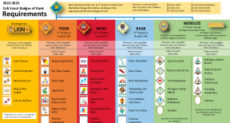 Back when most of us were teenagers, what we now know as “social media” consisted of long hours tying up the family telephone chatting with our friends, or perhaps time spent cruising the boulevards or at the town soda shop. Times have changed and so has the technology, and our teenagers communicate by all manner of instant electronic means.
Back when most of us were teenagers, what we now know as “social media” consisted of long hours tying up the family telephone chatting with our friends, or perhaps time spent cruising the boulevards or at the town soda shop. Times have changed and so has the technology, and our teenagers communicate by all manner of instant electronic means.
Early commercial online chat services such as Prodigy and Compuserve eventually gave way to the king of instant messaging, America Online. It seemed like anyone who was online had an AOL account, and when Internet connectivity became widespread, so did AOL Instant Messenger. “I-M me” was a popular phrase, and rather than exchanging phone numbers, screen names were the lingua franca of the early online world. New services like Friendster and MySpace gave way to the reigning champion, Facebook. Adoption of Facebook spread from the original college audience to just about everyone, including commercial interests, and it looked as if Facebook messaging was going to supplant e-mail as the dominant form of communication online.
But not so fast. Just as teens migrated from AOL to MySpace, and then to Facebook, it looks like another shift is in the works. The share of teens who consider Facebook as their most popular social network is actually starting to drop, from 42 percent a year ago to 23 percent today. Â What’s replacing it? Twitter, for one. Once the domain of middle-aged users describing what they had for lunch, Twitter has become an important microblogging medium where one can not only post pearls of wisdom (as we do from time to time) and follow breaking news as it happens, but can also have private chats in a format easier than text messaging. Photo-sharing sites, notably Instagram, are also picking up popularity among young users, posting everything from “selfies” to pictures of their pets to short video clips. Snapchat, in which a photo appears for a fleeting few seconds on the recipient’s smartphone, is used almost second-naturedly by high-schoolers, and the Chinese service WeChat has picked up global users by the millions. There is even evidence that old-fashioned e-mail is making a comeback.
So what happened to Facebook? Many say it’s gotten so out of hand that a lot of its features have become almost meaningless. Your “friends” on Facebook are not really your friends when you amass hundreds or even thousands of them. And these “friends” love to brag about the most mundane things in the endless quest for that coveted “like”. In fact, Facebook is being taken over by moms as well as business interests who hope you’ll “like” their product or service in exchange for a discount or bonus, becoming part of their marketing effort in the process.
All this is to say that our Scouts cannot rely on a single mode of electronic communication to reach everyone, nor can we adults consistently use a given platform for communication with families. Sure, e-mail lists work for mass distribution of non-time-critical information, as do websites for news and reference material like forms, maps and the like. And the danger in any form of electronic communication is its permanence and the likelihood that information may “escape” and reach unintended recipients.
So how do we communicate reliably?
Fortunately, Scouting gives us a framework for reliable communication within our membership, and it’s the same mechanism that powers all of Scouting — the patrol method. When it’s applied properly, and not merely used as a convenient way to organize and categorize Scouts, the patrol method fosters communication within a troop by encouraging and supporting the orderly distribution of information in both directions. (You might recall the “GGI” exercise from National Youth Leadership Training, in which youth leaders practice various means of getting and giving information.) This form of communication involves not only passing information but verifying that it was received – “closing the loop”, as Clarke Green has described it.
Here’s an example of how patrol method communication works. Suppose the patrol leaders’ council gets word at the last minute that the troop meeting site has to be moved. The adult reaction would be to send out an e-mail to the troop notifying them of the change. More forward-thinking troops might also put the information on their website or on Twitter. But these methods rely on the recipients actively checking and reading their e-mail or Twitter feeds, and a website is a poor way to “push” information. But a more effective way to forward the information is for the Scouts to do it themselves. The Scoutmaster notifies the senior patrol leader, who gets on the telephone (remember the phone?) and calls each of the patrol leaders to inform them of the change. Patrol leaders in turn call the members of their patrols and pass the word along. It’s a classic example of getting and giving information, as well as closing the loop, because each phone call is (hopefully) a complete transaction, where the patrol members each receive a call from their patrol leader. The proliferation of cellphones means that nearly everyone of Boy Scout age has one now, and text messaging can also work as well as voice calling. Texting can provide a written record of the information sent and a confirmation that it was received.
The debate on which form of communication is best for a troop is ongoing and will probably never have a definitive answer. Each new method that comes along offers promise but requires buy-in. The important thing to remember is not which platform we use, but that communication is effective, reaches the intended target, and gives the boys responsibility for this important aspect of their troop.
Illustration by superkitmod / freedigitalphotos.net
This post first appeared on Bobwhite Blather.




A great piece that I apply, but not through the Patrol Method, because we have a venturing crew, not a troop, we define the issue as team communication instead.
I like to use the term that I also took from Clarke Green of tier I & tier II communications. Tier I is a phone call or some form of short two way communication, like an exchange of text messages or conversation over the phone on a topic. Tier II is everything else that does not always have a respond included from twitter, email to Facebook and Google Plus.
As a requirement of the crew, the members share the best method of tier II communication they prefer to respond to. At the same time you can see a different event between ages within a single scouting unit, older and younger scouts or crew members often use different methods as they mature. When my crew members enter college, all of a sudden they start reading email, something they never did in high school.